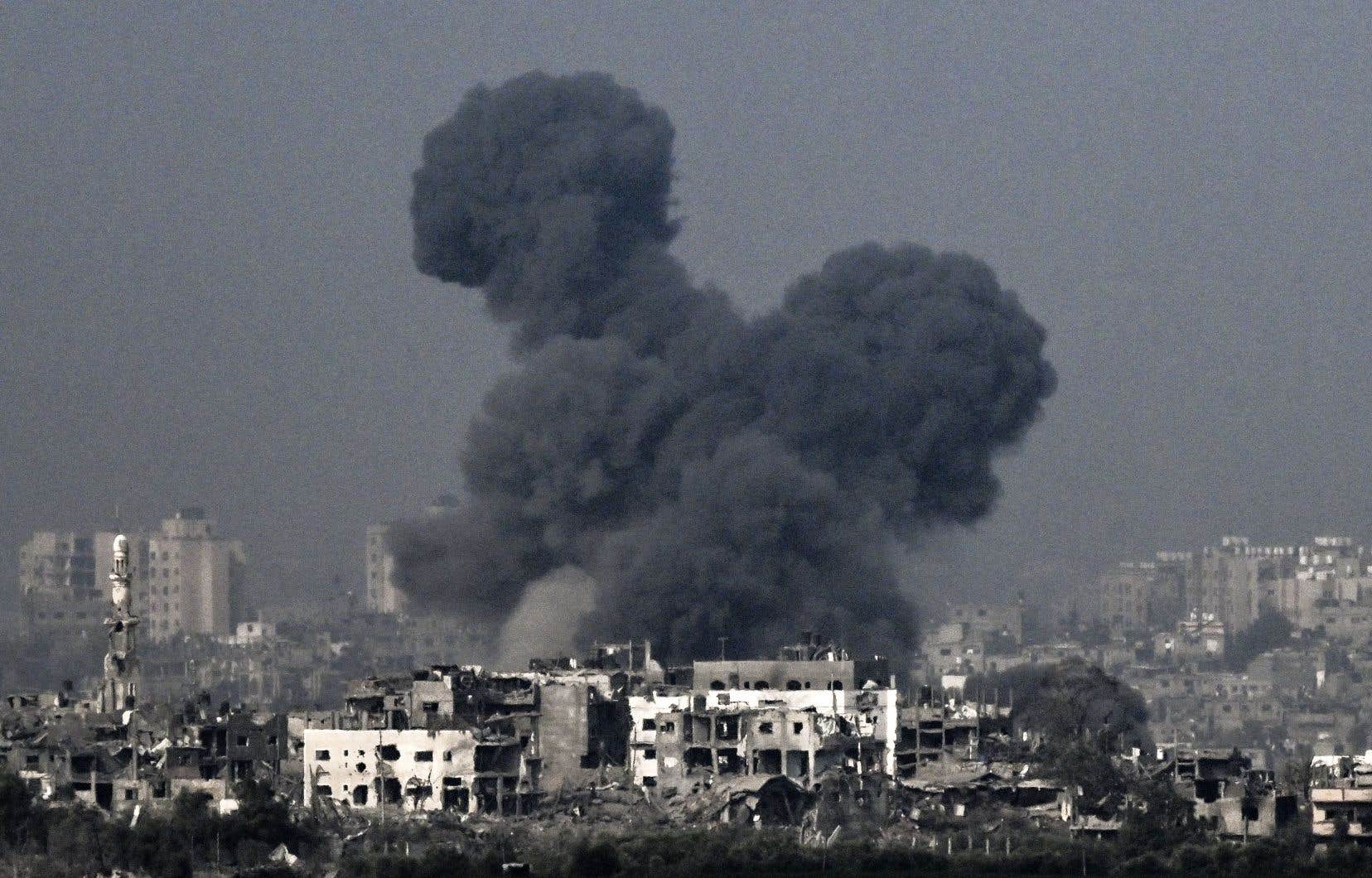The Israeli army relentlessly bombarded the Gaza Strip on Saturday after a night of intense strikes that destroyed hundreds of buildings according to rescuers, three weeks after the start of a war sparked by the deadliest attack in the history of Israel.
At 22e day of the conflict which left thousands dead, the Palestinian territory of Gaza, besieged by Israel and where some 2.4 million inhabitants are crowded together deprived of everything, is now cut off from the world due to the shutdown of telecommunications and the Internet.
The UN has said it fears an “avalanche of human suffering” in Gaza, where the Israeli army has been carrying out a devastating bombing campaign since October 7 in retaliation for an attack by Palestinian Hamas in which more than 1,400 people were killed in Israel, mainly civilians, according to authorities.
Gaza’s ruling Hamas health ministry said 7,703 people, mostly civilians including more than 3,500 children, had been killed in Israeli bombings, the highest death toll in a war in Gaza since the withdrawal. Israeli territory from the Palestinian territory in 2005 after 38 years of occupation.
The army announced that it had struck “150 underground targets” overnight in the north of the Gaza Strip, where according to it Hamas directs its operations from a gigantic network of underground tunnels.
She reported “several Hamas terrorists killed” including a leader “who took part in the organization of the October 7 massacre.”
According to the spokesperson for Civil Defense in Gaza, Mahmoud Bassal, “hundreds of buildings and houses were completely destroyed” in the nighttime raids.
The heaviest bombings, according to testimonies, were concentrated on areas around two hospitals, al-Shifa in Gaza City and another in the Jabaliya area further north.
“It was bombing everywhere”
In the Shati refugee camp, within the limits of Gaza City, the bombings caused significant damage.
“What happened in Chati is worse than an earthquake,” resident Alaa Mahdi, 54, told AFP. “It was bombing everywhere, the navy, the artillery and the planes. Who are they hitting, the resistance? No, poor people. »
Aerial and artillery bombardments continued on Saturday against Gaza after hours of continuous bombings and strikes overnight that shook the windows and ground of Ashkelon, a town in southern Israel close to Gaza, according to AFP journalists in the region.
Smoke and an acrid burning smell filled the air at sunrise in Ashkelon and Sderot, while fighter jets continued to fly at low altitude and detonations could be heard coming from Gaza.
During the night, Hamas, which said it was “ready” to face an Israeli ground offensive, reported clashes between its fighters and soldiers in Beit Hanoun (north) and al-Boureij (center), and fired salvos of rockets towards Israel.
After announcing an intensification of its “significantly” strikes on Friday evening, the army confirmed on Saturday that its forces had “entered Gaza and expanded their operations there”, after two incursions the previous two nights.
“We will continue to bomb from the air and the sea,” said army spokesman Daniel Hagari.
“Anguish” of hostage families
At the end of “a night of immense anguish”, the families of the hostages, the majority Israeli, held by Hamas in Gaza said they were “worried” about their fate and demanded explanations from the government.
According to the army, nearly 230 hostages, Israeli, binational or foreign, were taken to Gaza on October 7 by Hamas, which has since released four women. Hamas estimated Thursday that “nearly 50” hostages had been killed in Israeli bombings.
On Saturday, a senior Hamas official, Moussa Abou Marzouk, said in Moscow that his movement was trying to determine the location of eight hostages with dual Russian and Israeli nationality in order to free them.
Russia, unlike the United States, the European Union and Israel, does not consider Hamas a “terrorist” organization.
The intense nighttime bombardments coincided with a communications and internet blackout in Gaza.
NGOs and UN agencies have reported losing contact with their teams in Gaza.
Humanitarian operations and hospital activity “cannot continue without communications,” said Lynn Hastings, a UN official.
“Serve as a cover”
“This blackout of information risks serving as a cover for mass atrocities,” Human Rights Watch warned.
On October 9, Israel imposed a “total siege” on Gaza, cutting off water, electricity and food supplies, while the Palestinian territory had already been subject to an Israeli land, air and sea blockade for more than 16 years.
“Many more” people will “soon die” due to the siege, said the head of the UN agency for Palestinian refugees (UNRWA), Philippe Lazzarini.
On Saturday, Israeli spokesperson Daniel Hagari said the army “will today allow the entry of food, medicine and water for the population” of Gaza.
Since October 21, only 84 trucks of humanitarian aid have arrived in Gaza from Egypt according to the UN, when at least a hundred are needed per day.
“Stop this madness”
In New York, the UN General Assembly demanded by a large majority an “immediate humanitarian truce”, a resolution welcomed by Hamas but rejected by Israel.
Israel wants to “annihilate” Hamas after the October 7 attack. That day, in the middle of Shabbat, the weekly Jewish rest, hundreds of Hamas fighters infiltrated Israeli soil from Gaza, where they carried out the deadliest attack in Israeli history.
“Intensified Israeli bombardments on Gaza have once again targeted women, children and innocent civilians […] Israel must immediately stop this madness,” Turkish President Recep Tayyip Erdogan said on X (formerly Twitter).
A ground offensive in Gaza worries the international community which fears a regional conflagration, while Iran, support of Hamas and Lebanese Hezbollah, has issued warnings to the United States, a close ally of Israel.
Tension is very high in the West Bank, Palestinian territory occupied by Israel since 1967, where more than 100 Palestinians have been killed by Israeli soldiers or settlers since October 7.
And on Israel’s northern border with Lebanon, where exchanges of fire are almost daily between the Israeli army and Hezbollah.
